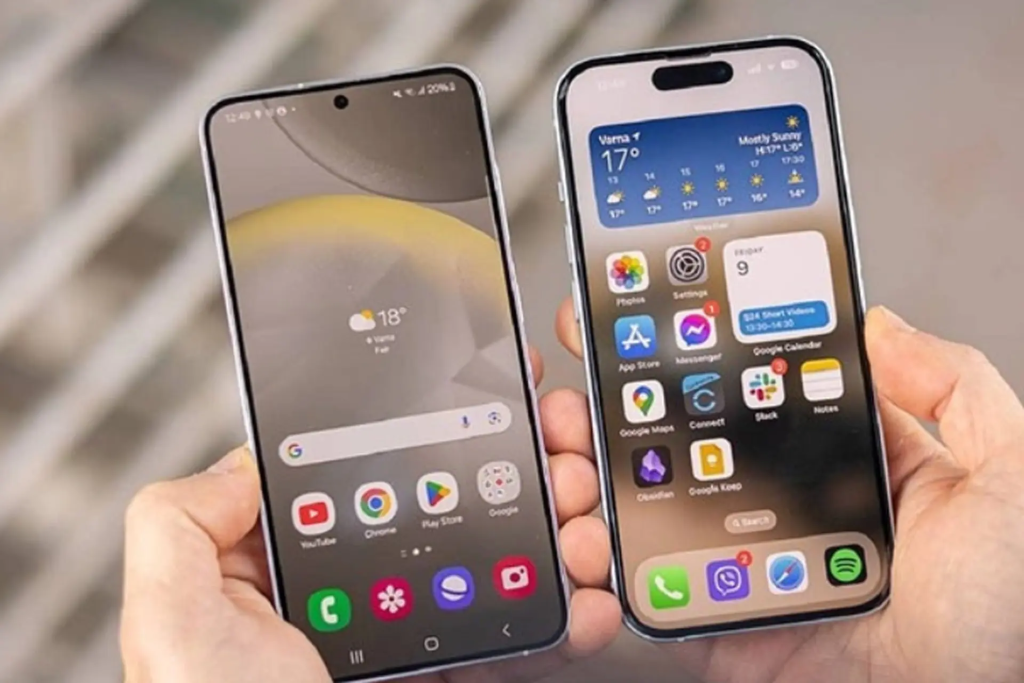Are you wondering whether the Galaxy S25 or iPhone 16 offers better value? Many consumers are asking the same question when deciding between these flagship devices. This comprehensive comparison breaks down what each phone brings to the table.

Introduction to the Galaxy S25 and iPhone 16
The Galaxy S25 is Samsung’s latest flagship, unveiled at the Galaxy Unpacked 2025 event as part of their premium S-series lineup. As the most affordably priced model in the range, it directly competes with Apple’s iPhone 16 in the high-end smartphone segment.
Samsung’s Galaxy S25 offers an impressive package: compact design with excellent build quality, a vibrant display, powerful performance, versatile camera system, and all-day battery life. Meanwhile, Apple’s iPhone 16, introduced last fall as part of their four-model premium lineup, stands out with its Dynamic Island display, powerful A18 3nm chip, feature-rich iOS 18, and exceptional video recording capabilities.
Design Comparison: Premium Aesthetics with Distinct Identities
The Galaxy S25 and iPhone 16 feature distinctly different design languages that showcase each company’s aesthetic approach.
Samsung’s Galaxy S25 embraces a modern flat design with a single punch-hole camera on the front, providing a cleaner look than Apple’s solution. Its premium aluminum frame and glass back house a vertically-aligned triple camera system that creates a cohesive, eye-catching appearance.

The iPhone 16 features a modern flat front with a pill-shaped cutout housing the selfie camera and Face ID sensors, surrounded by ultra-thin bezels. Its durable aluminum frame pairs with a glossy glass back, complemented by a compact pill-shaped camera island in the upper left corner. Apple also introduced two new physical controls—the Action Button and Camera Control—offering additional customization and functionality.

Both devices boast excellent build quality with IP68 water and dust resistance for added durability. Your preference between these designs will ultimately depend on personal aesthetic taste.
Display: Samsung’s Edge in Brightness and Refresh Rate
The Galaxy S25 comes equipped with a 6.2-inch Dynamic AMOLED 2X display featuring 1080 x 2340 resolution, adaptive 1-120Hz refresh rate, and peak brightness of 2,600 nits, delivering exceptional visual quality.

The iPhone 16, slightly more compact with its 6.1-inch OLED screen, offers 1179 x 2556 resolution but is limited to a standard 60Hz refresh rate and 2,000 nits peak brightness. This gives the Galaxy S25 an advantage in motion handling, web browsing, gaming smoothness, and visibility in bright sunlight.
Performance: Powerhouse Processors in Both Devices
Both smartphones deliver exceptional performance with their cutting-edge processors. Samsung exclusively equips the Galaxy S25 with Qualcomm’s most powerful Snapdragon 8 Elite for Galaxy chip, manufactured on an advanced 3nm process with custom Oryon cores. This provides outstanding performance, especially for multitasking and AI applications.
Though not Apple’s most powerful chip, the iPhone 16’s A18 3nm processor delivers impressive performance for demanding tasks, including graphically intensive games and 4K video rendering.
Memory configurations start at 128GB storage for both devices, though the Galaxy S25 offers 12GB RAM compared to the iPhone 16’s 8GB, potentially providing better multitasking capabilities.
On the software front, the Galaxy S25 runs Android 15 with One UI 7, while the iPhone 16 operates on iOS 18. Both feature intuitive interfaces and AI capabilities, with Samsung promising seven years of OS and security updates compared to Apple’s track record of at least five years of iOS support.
Camera Systems: Galaxy’s Versatility vs iPhone’s Dual Setup
The Galaxy S25 features a triple-camera system: a 50MP main sensor, 12MP ultra-wide, and 10MP telephoto with 3x optical zoom.
In contrast, the iPhone 16 offers a dual-camera configuration with a 48MP main sensor and 12MP ultra-wide. The Galaxy S25’s additional telephoto lens provides greater versatility, particularly for portrait photography. However, real-world image quality comparisons will need to wait until the Galaxy S25 hits the market.
For selfies, both phones use 12MP front-facing cameras with beauty algorithms and high-quality video call capabilities.
Battery Life and Charging: Comparable Daily Endurance
The Galaxy S25 houses a 4,000 mAh battery supporting 25W wired fast charging, 15W wireless charging, and reverse wireless charging. The iPhone 16 offers up to 22 hours of video playback with fast charging that delivers 50% charge in 30 minutes, plus 25W MagSafe wireless charging, 15W Qi 2 wireless charging, and 4.5W reverse wireless charging.
Both phones should comfortably last through a full day of typical usage without battery concerns.
Comparison table of Samsung Galaxy S25 and iPhone 16 parameters
Compare the most complete detailed parameters of Samsung Galaxy S25 and iPhone 16:
| Specification | Samsung Galaxy S25 | Apple iPhone 16 |
|---|---|---|
| Dimensions | 146.9 x 70.4 x 7.2 mm, Weight: 159 g | 147.6 x 71.6 x 7.8 mm, Weight: 170 g |
| Display | 6.2-inch Dynamic LTPO AMOLED 2X, 1080 x 2340 pixels, | 6.1-inch Super Retina XDR OLED, 1179 x 2556 pixels, |
| 1-120Hz refresh rate, 2600 nits peak brightness, Corning Gorilla Glass Victus 2 | 60Hz refresh rate, 2000 nits peak brightness, Ceramic Shield Glass | |
| CPU and GPU | Snapdragon 8 Elite for Galaxy (3 nm), Adreno 830 GPU | Apple A18 (3 nm), Apple GPU |
| RAM/Storage | 12GB RAM, 128GB/256GB/512GB internal storage | 8GB RAM, 128GB/256GB/512GB internal storage |
| Rear Camera | 50MP (main) + 12MP (ultrawide) + 10MP (3x telephoto) | 48MP (main) + 12MP (ultrawide) |
| Front Camera | 12MP, f/2.2 | 12MP, f/1.9 |
| Operating System | Android 15, One UI 7 | iOS 18 |
Which Should You Buy?
If you prioritize stable performance, quality display, and integration with Apple’s ecosystem, the iPhone 16 makes an excellent choice.
If you prefer a brighter, smoother display and a more versatile camera system with telephoto capabilities, the Galaxy S25 might better suit your needs.
Conclusion
Both the Galaxy S25 and iPhone 16 represent the best flagship offerings currently available. The choice ultimately depends on your personal preferences, ecosystem investment, and specific usage requirements. Whether you value Samsung’s display technology and camera versatility or Apple’s performance consistency and ecosystem, both devices deliver premium smartphone experiences.




